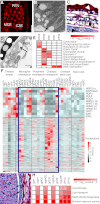Comprehensive developmental profiles of gene activity in regions and subregions of the Arabidopsis seed
- PMID: 23319655
- PMCID: PMC3562769
- DOI: 10.1073/pnas.1222061110
Comprehensive developmental profiles of gene activity in regions and subregions of the Arabidopsis seed
Abstract
Seeds are complex structures that consist of the embryo, endosperm, and seed-coat regions that are of different ontogenetic origins, and each region can be further divided into morphologically distinct subregions. Despite the importance of seeds for food, fiber, and fuel globally, little is known of the cellular processes that characterize each subregion or how these processes are integrated to permit the coordinated development of the seed. We profiled gene activity genome-wide in every organ, tissue, and cell type of Arabidopsis seeds from fertilization through maturity. The resulting mRNA datasets offer the most comprehensive description of gene activity in seeds with high spatial and temporal resolution,providing unique insights into the function of understudied seed regions. Global comparisons of mRNA populations reveal unexpected overlaps in the functional identities of seed subregions. Analyses of coexpressed gene sets suggest that processes that regulate seed size and filling are coordinated across several subregions. Predictions of gene regulatory networks based on the association of transcription factors with enriched DNA sequence motifs upstream of coexpressed genes identify regulators of seed development. These studies emphasize the utility of these data sets as an essential resource for the study of seed biology.
Conflict of interest statement
The authors declare no conflict of interest.
Figures







References
-
- Steeves TA. The evolution and biological significance of seeds. Can J Bot. 1983;61(12):3550–3560.
-
- Godfray HCJ, et al. Food security: The challenge of feeding 9 billion people. Science. 2010;327(5967):812–818. - PubMed
-
- Ohto M, Stone SL, Harada JJ. Genetic control of seed development and seed mass. In: Bradford KJ, Nonogaki H, editors. Seed Development, Dormancy, and Germination. Oxford: Blackwell; 2007. pp. 1–24.
-
- Brown RC, Lemmon BE, Nguyen H, Olsen O-A. Development of endosperm in Arabidopsis thaliana. Sex Plant Reprod. 1999;12(1):32–42.
Publication types
MeSH terms
Substances
Associated data
- Actions
Grants and funding
LinkOut - more resources
Full Text Sources
Other Literature Sources
Molecular Biology Databases

